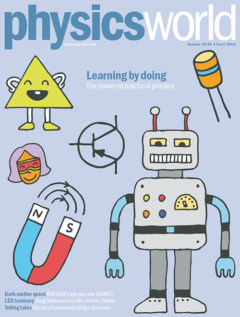Even if you’re a hardcore theoretical physicist, I’m sure you’ll agree that experiments are the lifeblood of physics. After all, theory and experiment go hand in hand – and there’s nothing to beat getting your hands dirty to get a proper understanding of the subject.
But how can pupils and students get excited about experiments? Making practical work a key part of exam syllabuses is surely important – yet the danger then is experimental work becomes a chore not a charm.

If you need inspiration, check out the April issue of Physics World magazine, which is now out in print and digital formats. It contains a great feature by Neil Downie – head of sensors at Air Products, Basingstoke, Hampshire, UK and a Royal Academy of Engineering visiting professor at the University of Surrey.
Having run “Saturday science clubs” for children for more than two decades, Downie presents in the feature his five best physics demonstrations of all time. He’s also teamed up with Physics World to create a set of five short films, each showing one of the demos in action.
Apart from being simple and quick to carry out, the beauty of the five demos is that while you don’t need much equipment to get started, you can take the projects in lots of different directions.
If you’re a member of the Institute of Physics (IOP), you can get immediate access to the feature and all five videos with the digital edition of the magazine on your desktop via MyIOP.org or on any iOS or Android smartphone or tablet via the Physics World app, available from the App Store and Google Play. If you’re not yet in the IOP, you can join as an IOPimember for just £15, €20 or $25 a year to get full digital access to Physics World.
We’ve also included the first of Downie’s films above to whet your appetite, in which he shows the principles of the “Vacuum Bazooka”.
For the record, here’s a rundown of what else is in the issue.
• UK and Italy vie over telescope HQ – An Italian bid to host the headquarters of the world’s largest radio telescope has been judged superior to a British proposal – yet it has failed to get the green light. Edwin Cartlidge reports
• Filling the world with light – After sharing the 2014 Nobel Prize for Physics for the discovery of efficient blue light-emitting diodes (LEDs), Shuji Nakamura talks to Michael Banks about what comes next
• Fostering talent – Science can only blossom if young researchers are rewarded for their growth rather than their “academic ancestry”, says Abraham Loeb
• Fight over light – Robert P Crease explains the fascination with Goethe’s flawed book Theory of Colours, which savagely attacked Newton’s book Opticks
• Communicating discovery – So you’ve made a scientific discovery – what next? Communicating your finding to the public without succumbing to the many pitfalls along the way is a tricky business, as Simon Perks reports
• The will of the WISPs – While many physicists hunt dark matter in the form of WIMPs – “weakly interacting massive particles” – others have turned their attention to a lighter prey: “weakly interacting slim particles”, or WISPs. Edwin Cartlidge reports
• Five amazing physics demonstrations – There’s nothing better than a good physics demonstration to illustrate the subject’s fundamental principles. Neil Downie, who has run Saturday science clubs for children for more than two decades, presents his five best demos of all time
• Bringing the quantum to life – Marta Varela reviews Life on the Edge: the Coming of Age of Quantum Biology by Jim Al-Khalili and Johnjoe McFadden
• Albert and Erwin: decline and fall – Denis Weaire reviews Einstein’s Dice and Schrödinger’s Cat: How Two Great Minds Battled Quantum Randomness to Create a Unified Theory of Physics by Paul Halpern
• Freeze brain – The challenge of designing the equipment that makes low-temperature
science possible has kept Roger Mitchell fascinated throughout his 30-year career at the UK firm Cryogenic, where he is now technical director
• Once a physicist – John Harte, an ecologist in the Energy and Resources Group at the University of California, Berkeley, US
• Physics on a coffee break – Karen Yates from Imperial College London, muses over the importance of coffee in physics



